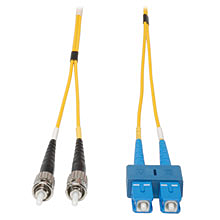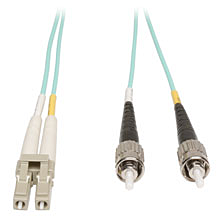When searching the Internet for network fiber patch cables, the first decision you often encounter is singlemode or multimode. Hopefully, I can make that decision easier for you by explaining the differences between the two, and why you should choose one over the other.
Single Mode vs. Multimode Fiber: The Core of the Matter
First and foremost, the core of all fiber cables carries light to transmit data. The main difference between singlemode and multimode fiber patch cables is the size of their respective cores. Singlemode cables have a core of 8 to 10 microns. In single mode cables, light travels toward the center of the core in a single wavelength. This focusing of light allows the signal to travel faster and over longer distances without a loss of signal quality than is possible with multimode cabling. Multimode cables have a core of either 50 or 62.5 microns. In multimode cables, the larger core gathers more light compared to singlemode, and this light reflects off the core and allows more signals to be transmitted. Although more cost-effective than singlemode, multimode cabling does not maintain signal quality over long distances.
Multimode or Single Mode: Making the Right Choice

Singlemode Fiber Patch Cables are the best choice for transmitting data over long distances. They are usually used for connections over large areas, such as college campuses and cable television networks. They have a higher bandwidth than multimode cables to deliver up to twice the throughput. Most singlemode cabling is color-coded yellow.

Multimode Fiber Patch Cables are a good choice for transmitting data and voice signals over shorter distances. They are typically used for data and audio/visual applications in local-area networks and connections within buildings. Multimode cables are generally color-coded orange or aqua; the Aqua Fiber Patch Cables are for higher performance 10Gbps, 40Gbps, and 100Gbps Ethernet and fiber channel applications.





